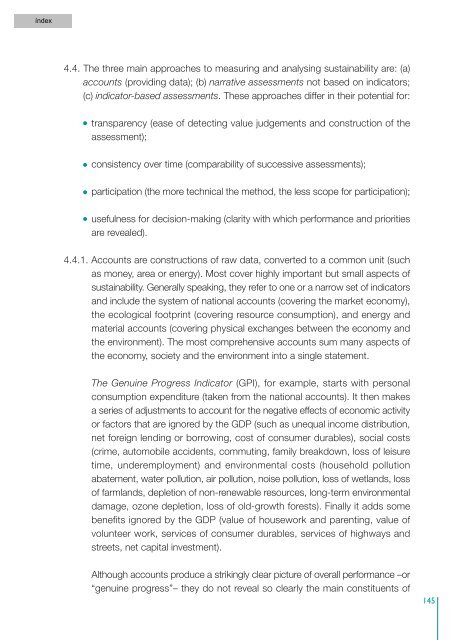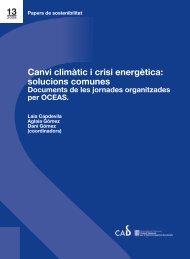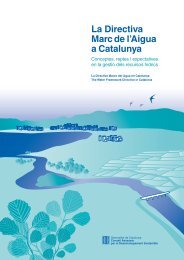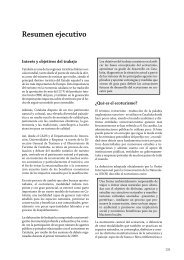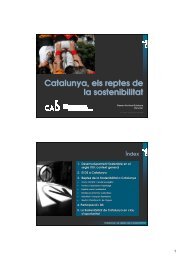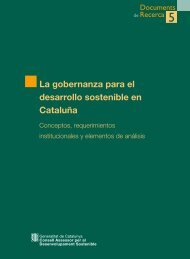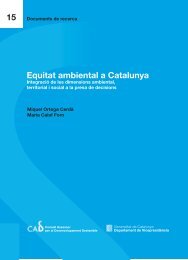Estratègies per al desenvolupament sostenible - Generalitat de ...
Estratègies per al desenvolupament sostenible - Generalitat de ...
Estratègies per al desenvolupament sostenible - Generalitat de ...
Create successful ePaper yourself
Turn your PDF publications into a flip-book with our unique Google optimized e-Paper software.
4.4. The three main approaches to measuring and an<strong>al</strong>ysing sustainability are: (a)accounts (providing data); (b) narrative assessments not based on indicators;(c) indicator-based assessments. These approaches differ in their potenti<strong>al</strong> for:transparency (ease of <strong>de</strong>tecting v<strong>al</strong>ue judgements and construction of theassessment);consistency over time (comparability of successive assessments);participation (the more technic<strong>al</strong> the method, the less scope for participation);usefulness for <strong>de</strong>cision-making (clarity with which <strong>per</strong>formance and prioritiesare reve<strong>al</strong>ed).4.4.1. Accounts are constructions of raw data, converted to a common unit (suchas money, area or energy). Most cover highly important but sm<strong>al</strong>l aspects ofsustainability. Gener<strong>al</strong>ly speaking, they refer to one or a narrow set of indicatorsand inclu<strong>de</strong> the system of nation<strong>al</strong> accounts (covering the market economy),the ecologic<strong>al</strong> footprint (covering resource consumption), and energy andmateri<strong>al</strong> accounts (covering physic<strong>al</strong> exchanges between the economy andthe environment). The most comprehensive accounts sum many aspects ofthe economy, society and the environment into a single statement.The Genuine Progress Indicator (GPI), for example, starts with <strong>per</strong>son<strong>al</strong>consumption expenditure (taken from the nation<strong>al</strong> accounts). It then makesa series of adjustments to account for the negative effects of economic activityor factors that are ignored by the GDP (such as unequ<strong>al</strong> income distribution,net foreign lending or borrowing, cost of consumer durables), soci<strong>al</strong> costs(crime, automobile acci<strong>de</strong>nts, commuting, family breakdown, loss of leisuretime, un<strong>de</strong>remployment) and environment<strong>al</strong> costs (household pollutionabatement, water pollution, air pollution, noise pollution, loss of wetlands, lossof farmlands, <strong>de</strong>pletion of non-renewable resources, long-term environment<strong>al</strong>damage, ozone <strong>de</strong>pletion, loss of old-growth forests). Fin<strong>al</strong>ly it adds somebenefits ignored by the GDP (v<strong>al</strong>ue of housework and parenting, v<strong>al</strong>ue ofvolunteer work, services of consumer durables, services of highways andstreets, net capit<strong>al</strong> investment).Although accounts produce a strikingly clear picture of over<strong>al</strong>l <strong>per</strong>formance –or“genuine progress”– they do not reve<strong>al</strong> so clearly the main constituents of145


